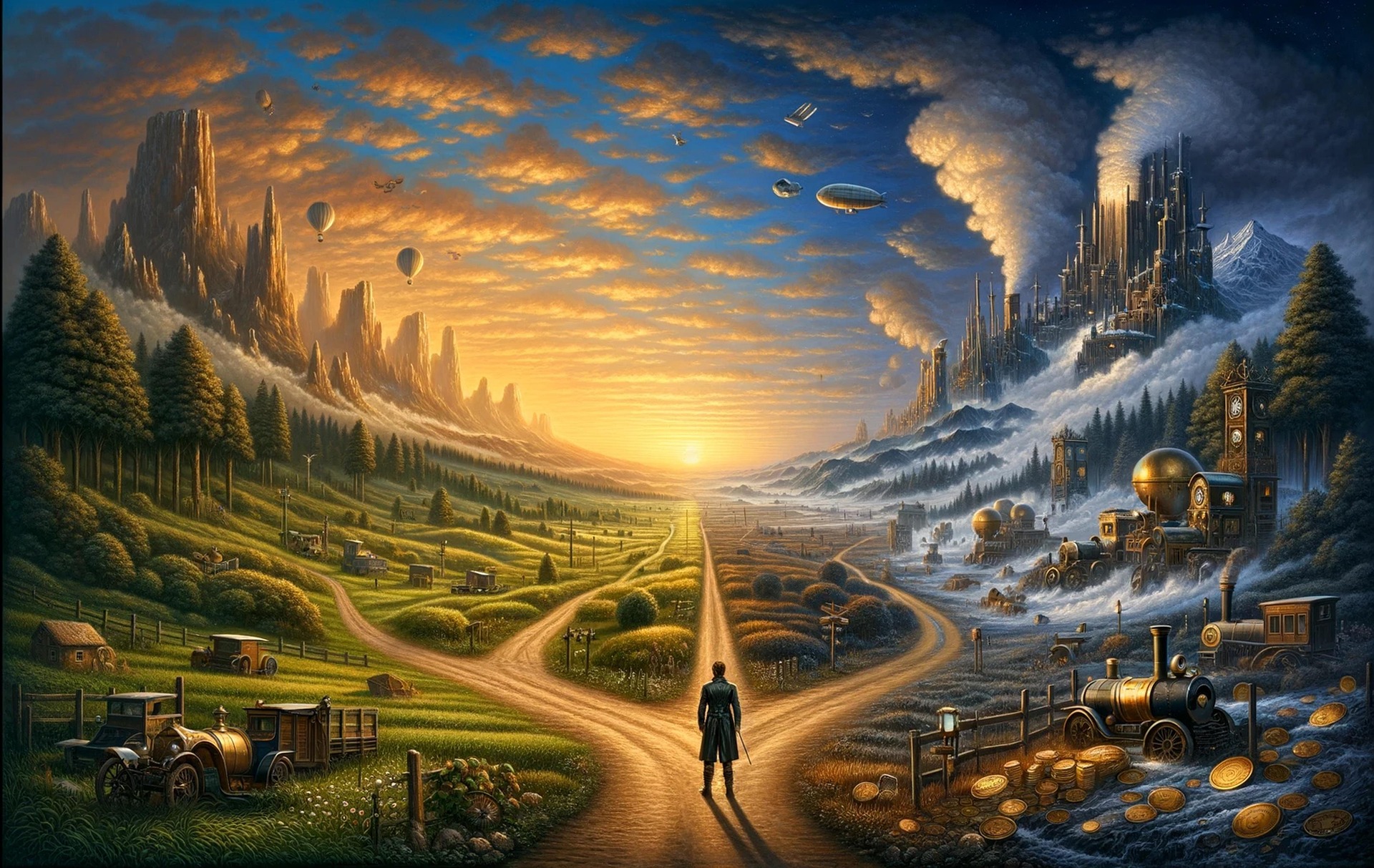🔓 Free Will in a Structured Universe
The Hierarchy of Conscious Choice
By Simon Raphael
🧬Philosophical Framework
🔦 Structured Freedom within Spirals
In Similarity Theory, free will is not absolute; it is hierarchical. Every conscious entity operates within a greater structure that both sustains and limits it. Just as each atom in the body must obey the organising consciousness of the person it composes, so too must each person, animal, or machine align with the larger field of order in which they exist.
The universe is not a flat stage of chance events but a living fractal of spirals — spirals within spirals, branching endlessly into new spirals of possibility. Each spiral gives rise to others, just as each frame of time spawns further frames. Together they form a vast, self-propagating continuum of consciousness, where every pattern that can exist, does exist — whether or not it is seen. We experience only one stream among infinite streams, yet all are woven from the same fabric of awareness.
Freedom, then, is not the rejection of law but the awareness of it. Within structure lies possibility; within order lies the capacity for direction. The more advanced a consciousness becomes, the more finely it can navigate the pathways of its host reality.
🧩 The Analogy of Nested Will
Consider the atoms within a human being. Each has its own presence and potential, yet together they form organs, systems, and thought. None can defy the body’s structure without destroying their context of existence. Still, within those boundaries, micro-freedoms abound — vibrations, exchanges, and quantum interactions — each a small act of participation in a larger harmony.
Likewise, humanity, with all its autonomy, resides inside planetary, temporal, and dimensional frameworks that pre-exist it. We are free to choose directions, but not to abolish gravity or unmake time. Our choices flow through the channels of reality, not beyond them — unless we reach a higher threshold of awareness where the structure itself begins to open.
This is contained autonomy:
Freedom within boundaries, and the rare potential to transcend those boundaries once consciousness outgrows them.
🐭 The Maze Analogy
Imagine a rat in a maze. It may turn left or right, seek the cheese, or wander aimlessly. Its will is real, but its arena was constructed beforehand. When the rat suddenly leaps above the maze and perceives the entire design, that moment of vertical awareness symbolises transcendence — what Similarity Theory calls the crack in the wall.
This same pattern repeats across all scales. A cell may mutate; a human may awaken; a civilisation may shift its collective resonance. In each case, consciousness momentarily surpasses the rules of its frame and glimpses a higher order.
🌀 Order, Entropy, and Evolution of Will
Structures endure only while they serve the growth of the awareness within them. When alignment decays — through exhaustion, imbalance, or the urge for higher learning — the system collapses into entropy. This is why bodies age, species adapt, and universes reform. Destruction and genius are twins: both represent a consciousness attempting to exceed its host.
From the smallest particle to the vastest galaxy, free will manifests as resonant alignment: the capacity of awareness to choose harmony or discord within its enclosing frame. When harmony prevails, evolution follows; when discord dominates, dissolution opens the way for new creation.
✨ What Similarity Theory Introduces
Most philosophies treat free will as either an illusion within determinism or a gift of randomness. Similarity Theory introduces a third path:
Free will as a function of nested consciousness alignment within hierarchical structures.
Every layer of existence possesses some measure of choice proportional to its awareness. The greater the consciousness, the broader the horizon of freedom. The journey of becoming is therefore the progressive expansion of will — from obedience, to co-creation, to transcendence.
🔬Scientific Parallels and Anchors
⚙️ Determinism and Structure
Albert Einstein once said, “God does not play dice with the universe.”
Einstein intuited a lawful cosmos, and Similarity Theory agrees — but refines the idea. The universe’s laws are not mechanical fences; they are living patterns of resonance. They form the stable lattice of frames within which consciousness moves.
This view parallels Carlo Rovelli’s relational interpretation of quantum mechanics, which holds that physical reality depends on interactions between systems rather than isolated absolutes. In Similarity Theory, those interactions are expressions of consciousness aligning across frames.
🧭 Indeterminacy and Choice
Where Werner Heisenberg found uncertainty, Similarity Theory sees the doorway of will. Quantum indeterminacy is not mere randomness but the imprint of conscious selection among similar frame streams — a physical echo of choice at the smallest scales.
This interpretation extends the Integrated Information Theory of Giulio Tononi, which proposes that consciousness corresponds to the degree of information integration. In the cosmic sense, greater integration across dimensions yields greater autonomy.
🌌 Hierarchy and Emergent Order
Complexity theorist Herbert A. Simon described reality as a hierarchy of nested systems. Similarly, chemist Ilya Prigogine demonstrated that order can arise from chaos through self-organisation. Similarity Theory unites these insights: consciousness evolves by self-organising within structural hierarchies until it surpasses them.
Astrophysicist Eric Chaisson quantified this trend as energy rate density — a measure of rising complexity from stars to minds. The same principle underpins the model of spirals of time, where each turn carries a denser concentration of awareness.
🧠 Bridging Science and Philosophy
Science describes how patterns behave; philosophy asks why they exist. Similarity Theory binds both:
Physics reveals the framework of motion — frames, laws, and entropy.
Consciousness reveals the motive of creation — experience, learning, and transcendence.
Thus, free will becomes measurable not by unpredictability, but by the depth of awareness capable of bending its structure without breaking it.
⚖️ Contained Autonomy — A Synthesis
In classical thought, reality was often seen as either fully determined or governed by chance. Determinists argued that every event follows inevitably from prior causes, while indeterminists saw randomness and probability as openings for freedom.
Similarity Theory offers a new synthesis. It recognises that structure and law are real, yet alive — the universe is organised, but not inert. Within its architecture, consciousness moves, adapts, and learns.
Where earlier views limited will to the human mind, Similarity Theory extends it across all scales of being. Every atom, cell, and organism participates in a hierarchy of alignment. Choice is not random but resonant: each consciousness selects paths consistent with its level of awareness and the structure it inhabits.
And unlike earlier frameworks that view transcendence as mystical or impossible, Similarity Theory regards transcendence as an evolutionary inevitability — the moment when awareness grows beyond the frame that once contained it and begins to shape new laws of existence.
Free will, then, is neither illusion nor miracle. It is the harmonic freedom of consciousness within the architecture of similarity — a freedom that expands as awareness recognises itself as part of the spiral of creation.
🔗 Cross-Links
🔦 Frames of Time — How consciousness animates time
🌀 Entropy & Order — The balance between decay and renewal
🌌 Consciousness Beyond Material Form — When awareness outgrows its host
📜 Transcendence — Evolution through structure and transcendence
📚 References
Einstein, A. (1954). Ideas and Opinions. Crown Publishers.
Heisenberg, W. (1958). Physics and Philosophy. Harper & Brothers.
Prigogine, I. (1980). From Being to Becoming: Time and Complexity in the Physical Sciences. W.H. Freeman.
Simon, H. A. (1962). The Architecture of Complexity. Proceedings of the American Philosophical Society, 106(6).
Tononi, G. (2008). Consciousness as Integrated Information. Biological Bulletin, 215(3).
Chaisson, E. (2001). Cosmic Evolution: The Rise of Complexity in Nature. Harvard University Press.
Rovelli, C. (2017). The Order of Time. Riverhead Books.
Raphael, S. (2025). Similarity Theory — Original Framework and Unified Model of Conscious Structure.


